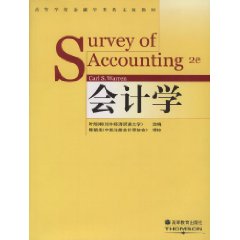
会计学(英文影印版)
原书名:Survey of Accounting
- 作者:Carl S.Warren
- 译者:
- 版次:2
- ISBN:9787040162233
- 出版时间:2005-01
- 出版社:高等教育出版社
- 定价:¥37.00 元
图书简介
《会计学》是为那些没有会计知识背景的读者学习会计学而编著的,《会计学》概括论述了财务会计和管理会计中的一些基础知识和基本理论问题,前10章主要阐述的是关于财务会计方面的论题;后5章主要阐述的是关于管理会计方面的内容。《会计学》的重点在于强调经理人、投资者或其他的公司股东应该如何使用公司财务报告,以便做出正确有效的经营决策。《会计学》中各章均安排了一些大公司的案例和“企业战略”模块,以作为论述的基础与起点,以便读者融会贯通,运用最新的会计理论来更好地指导丰富多彩的商务实践。
《会计学》可供金融、市场营销等非会计学专业本科生和MBA学生用做会计学教材。同时适合于那些从事贸易、金融、营销等领域的人士学习会计学使用。
作者简介
Carl S.Warren,美国乔治亚大学会计学客座教授,曾执教于衣阿华州立大学、密歇根州立大学和芝加哥大学。他在密歇根州立大学获得博士学位。Wareen教授执教25余年,讲授过会计学专业各种类型的课程,近期讲授会计学原理和审计等课程。
图书目录
CHAPTER 1 The Role of Accounting in Business
The Nature of Business
Types of Businesses
Forms of Business
Business Strategies
Value Chain of a Business
Business Stakeholders
Business Activities
Financing Activities
Investing Activities
Operating Activities
What Is Accounting and Its Role in Business?
Financial Statements
Income Statement
Retained Earnings Statement
Balance Sheet
Statement of Cash Flows
Interrelationships among Financial Statements
Accounting Concepts
Business Entity Concept
Cost Concept
Going Concern Concept
Matching Concept
Objectivity Concept
Unit of Measure Concept
Adequate Disclosure Concept
Accounting Period Concept
Horizontal Analysis
CHAPTER 2 The Cash Basis of Accounting
Elements of an Accounting System
Rules
Framework
Controls
Cash and Accrual Bases of Accounting
Using the Cash Basis of Accounting
Using the Accrual Basis of Accounting
Summary of Differences between the Cash and Accrual Bases of Accounting
Using the Cash Basis for a Corporation\'s First Period of Operations
Financial Statements for a Corporation\'s First Period of Operations
Income Statement
Retained Earnings Statement
Balance Sheet
Statement of Cash Flows
Using the Cash Basis for the Second Period of Operations
Advantages and Disadvantages of the Cash Basis
CHAPTER 3
The Accrual Basis of Accounting
The Accrual Basis of Accounting and the Matching Concept
Using the Accrual Basis of Accounting for Family Health Care\'s November Transactions
The Adjustment Process
Deferrals and Accruals
Adjustments for Family Health Care
Financial Statements
Interpreting Accrual and Cash Basis Income
The Accounting Cycle
Common-Size Financial Statements
CHAPTER 4
Accounting for Merchandise
Operations
Merchandise Operations
Financial Statements for a Merchandising Business
Multiple-Step Income Statement
Single-Step Income Statement
Retained Earnings Statement
Balance Sheet
Statement of Cash Flows
Sales Transactions
Cash Sales
Sales on Account
Sales Discounts
Sales Returns and Allowances
Purchase Transactions
Purchase Discounts
Purchase Returns and Allowances
Transportation Costs and Sales Taxes
Transportation Costs
Sales Taxes
Dual Nature of Merchandise Transactions
Merchandise Shrinkage
Gross Profit and Operating Profit Analysis
CHAPTER 5
Internal Control and Cash
Internal Control
Objectives of Internal Control
Elements of Internal Control
Prevention and Detection of Employee Fraud
Preventive Controls
Detective Controls
Risk Factors Relating to Employee Fraud
Examples of Employee Fraud
Cash Controls over Receipts and Payments
Control of Cash Receipts
Control of Cash Payments
Bank Accounts
Use of Bank Accounts
Bank Statement
Bank Accounts as a Control over Cash
Bank Reconciliation
Special-Purpose Cash Funds
Financial Statement Reporting of Cash
Cash Ratios
Ratio of Cash Flow to Net Income
Ratio of Cash to Monthly Cash Expenses
CHAPTER 6
Receivables and Inventories
Classification of Receivables
Accounts Receivable
Notes Receivable
Other Receivables
Uncollectible Receivables
Estimating Uncollectible Receivables
Sales Method
Aging-of-Receivables Method
Write-Offs of Customer Accounts
Classification of Inventories
Inventory Cost Flow Assumptions
Comparing Costing Methods
Use of Fifo Method
Use of Lifo Method
Use of Average Cost Method
Reporting Receivables and Inventory
Receivables
Inventory
Turnover Ratios
Accounts Receivable Turnover
Inventory Turnover
CHAPTER 7
Fixed Assets and Intangible Assets
Nature of Fixed Assets
Classifying Costs
The Cost of Fixed Assets
Accounting for Depreciation
Factors in Computing Depreciation Expense
Comparing Depreciation Methods
Depreciation for Federal Income Tax
Natural Resources
Fixed Asset Disposals
Discarding Fixed Assets
Selling Fixed Assets
Capital and Revenue Expenditures
Intangible Assets
Patents
Copyrights and Trademarks
Goodwill
Reporting Fixed Assets and Intangible Assets
Analyzing Fixed Assets
Operational Utilization Analyses
Financial Utilization Analysis
CHAPTER8
Liabilities and Stockholders\'Equity
Financing Operations
Liabilities
Current Liabilities
Notes Payable
Income Taxes
Contingent Liabilities
Payroll
Bonds
Stock
Common and Preferred Stock
Issuance of Stock
Reacquired Stock
Dividends
Cash Dividends
Stock Dividends
Stock Splits
Reporting Liabilities and Stockholders\' Equity
Earnings per Share
Analyze and Interpret Solvency
CHAPTER 9
Financial Statement Analysis
Basic Analytical Procedures
Horizontal Analysis
Vertical Analysis
Common-Size Statements
Other Analytical Measures
Solvency Analysis
Current Position Analysis
Accounts Receivable Analysis
Inventory Analysis
Ratio of Fixed Assets to Long-Term Liabilities
Ratio of Liabilities to Stockholders\' Equity
Number of Times Interest Charges Earned
Profitability Analysis
Ratio of Net Sales to Assets
Rate Earned on Total Assets
Rate Earned on Stockholders\' Equity
Rate Earned on Common Stockholders" Equity
Earnings per Share on Common Stock
Price-Earnings Ratio
Dividends per Share and Dividend Yield
Summary of Analytical Measures
Corporate Annual Reports
Financial Highlights
President\'s Letter to the Stockholders
Management Discussion and Analysis
Independent Auditors\' Report
Historical Summary
CHAPTER10
Accounting Systems for Manufacturing Businesses
Nature of Manufacturing Businesses
Manufacturing Cost Terms
Materials
Factory Labor
Factory Overhead Cost
Cost Accounting System Overview
Job Order Cost Systems for Manufacturing Businesses
Materials
Factory Labor
Factory Overhead Cost
Work in Process
Finished Goods and Cost of Goods Sold
Sales and Cost of Goods Sold
Period Costs
Summary of Cost Flows for Goodwell Printers
Job Order Costing for Decision Making
Job Order Cost Systems for Professional Service Businesses
Just-in-Time Manufacturing Principles
Reducing Inventory
Reducing Lead Times
Reducing Setup Time
Emphasizing Product-Oriented Layout
Emphasizing Employee Involvement
Emphasizing Pull Manufacturing
Emphasizing Zero Defects
Emphasizing Supplier Partnering
Activity-Based Costing
CHAPTER11
Cost Behavior and Cost-VolumeProfit Analysis
Cost Behavior
Variable Costs
Fixed Costs
Mixed Costs
Summary of Cost Behavior Concepts
Reporting Variable and Fixed Costs
Cost-Volume-Profit Relationships
Contribution Margin Concept
Mathematical Approach to Cost-Volume-Profit Analysis
Break-Even Point Target Profit
Graphic Approach to Cost-Volume-Profit Analysis
Cost-Volume-Profit (Break-Even) Chart
Profit-Volume Chart
Use of Computers in Cost-Volume-Profit Analysis
Sales Mix Considerations
Special Cost-Volume-Profit Relationships
Margin of Safety
Operating Leverage
Assumptions of Cost-Volume-Profit Analysis
CHAPTER 12 Differential Analysis and Product Pricing
CHAPTER 13 Budgeting and Standard Cost Systems
CHAPTER 14 Performance Evaluation for Decentralized Operations
CHAPTER 15 Capital Investment Analysis
辅助资料下载
| 资料名称 | 文件类型 | 文件大小 | 下载 |
|---|
Copyright © 2014 Cengage Learning Asia Pte Ltd. All Rights Reserved.
请您登陆后,再进行资料下载。
如果您还没有用户名和密码,请您点击“获取下载资格”按钮,进行申请表格填写,我们会及时跟您取得联系。